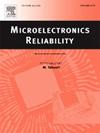Exploring the fracture mechanism of multilayer ceramic capacitors via combined simulation and experiment
IF 1.9
4区 工程技术
Q3 ENGINEERING, ELECTRICAL & ELECTRONIC
引用次数: 0
Abstract
As a basic component, multilayer ceramic capacitors (MLCCs) have been widely used in many engineering fields. Failure caused by printed circuit board flex deserves special attention throughout the entire lifecycle of MLCCs. In this failure pattern, the failure probabilities vary across different types of MLCCs. The initial damage location and the direction of cracking propagation display distinct characteristics. This paper presents the MLCC equivalent model by using homogenization theory in finite element method (FEM), and simulates the flex failure of different types of MLCCs. Three-point bending experiments are conducted to validate the FEM results, revealing the underlying cause of flex cracking. The failure pattern inferred by FEM aligns well with the experiment result, with the maximum error of only 7.56 %, demonstrating the equivalent model's effectiveness. Furthermore, we conduct a sensitivity analysis of geometric parameters, including the length-width ratio, terminal electrode width, stacking height, and solder joint height. Our study reveals the underlying mechanism of MLCC flex failure and identifies the key design factors influencing MLCC reliability. These findings provide valuable insights into the design, application, and enhancement of MLCC reliability.
通过仿真与实验相结合的方法,探讨了多层陶瓷电容器的断裂机理
多层陶瓷电容器作为一种基础元件,在许多工程领域得到了广泛的应用。在mlcc的整个生命周期中,印刷电路板挠性引起的故障值得特别关注。在这种失效模式中,不同类型的mlcc的失效概率不同。初始损伤位置和裂纹扩展方向表现出明显的特征。采用有限元法中的均质化理论,建立了MLCC的等效模型,并对不同类型MLCC的弯曲破坏进行了模拟。通过三点弯曲试验验证了有限元计算结果,揭示了弯曲开裂的根本原因。有限元分析所得的失效模式与试验结果吻合较好,最大误差仅为7.56%,证明了等效模型的有效性。此外,我们还对几何参数进行了灵敏度分析,包括长宽比、终端电极宽度、堆叠高度和焊点高度。我们的研究揭示了MLCC弯曲破坏的潜在机制,并确定了影响MLCC可靠性的关键设计因素。这些发现为MLCC可靠性的设计、应用和增强提供了有价值的见解。
本文章由计算机程序翻译,如有差异,请以英文原文为准。
求助全文
约1分钟内获得全文
求助全文
来源期刊

Microelectronics Reliability
工程技术-工程:电子与电气
CiteScore
3.30
自引率
12.50%
发文量
342
审稿时长
68 days
期刊介绍:
Microelectronics Reliability, is dedicated to disseminating the latest research results and related information on the reliability of microelectronic devices, circuits and systems, from materials, process and manufacturing, to design, testing and operation. The coverage of the journal includes the following topics: measurement, understanding and analysis; evaluation and prediction; modelling and simulation; methodologies and mitigation. Papers which combine reliability with other important areas of microelectronics engineering, such as design, fabrication, integration, testing, and field operation will also be welcome, and practical papers reporting case studies in the field and specific application domains are particularly encouraged.
Most accepted papers will be published as Research Papers, describing significant advances and completed work. Papers reviewing important developing topics of general interest may be accepted for publication as Review Papers. Urgent communications of a more preliminary nature and short reports on completed practical work of current interest may be considered for publication as Research Notes. All contributions are subject to peer review by leading experts in the field.
 求助内容:
求助内容: 应助结果提醒方式:
应助结果提醒方式:


